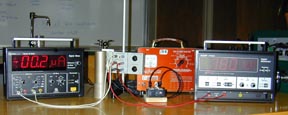
Stopping Voltage
# 7A10.30


| Description |
The apparatus can be used for studying the photoelectric effect and measuring Planck's constant. It shows that the kenetic energy of photoelectrons knocked out of a photosensitive surface depends on the color (and hence the frequency) but not on the intensity of the incident light. The aqqaratus consists of a photocell in which photoelectric emission occurs. The voltage applied to the tube can be adjusted by rheostat. If the voltage decreased and made negative the electrons ejected from the cathode will not have enough energy to reach the anode. At certain voltage called the "stopping voltage" or "cut-off voltage" the electron current from the cathode to the anode will become to zero. |
| Location and Notes |
Setup1: THORNTON Phototube unit PVB-100(16H) w/a high intensity
incandescent lamp; THORNTON Amplifier-Power supply unit APS-101(39 B) Setup2: WELCH Phototube unit 2120(16H) w/SPECTOLINE Mercury
lamp(15E) |